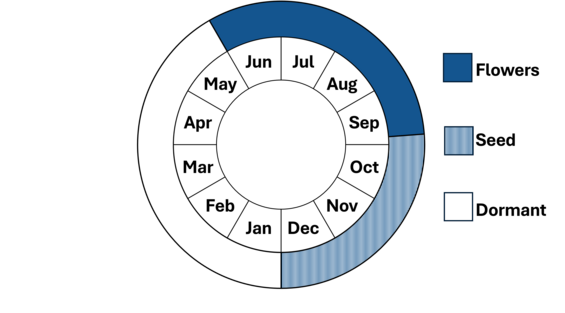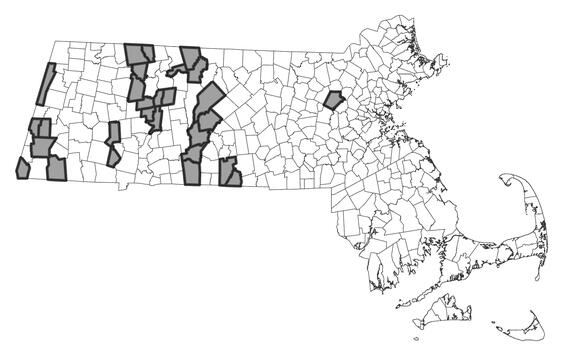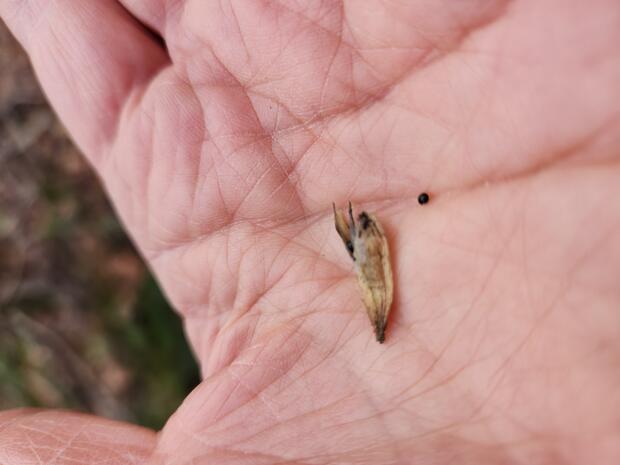- Scientific name: Adlumia fungosa (Aiton) Greene ex Britton, Sterns & Poggenb.
- Species of Greatest Conservation Need (MA State Wildlife Action Plan)
- Special Concern (MA Endangered Species Act)
Description
Climbing fumitory (Adlumia fungosa) is an herbaceous biennial vine that can reach lengths of 3m (10 feet). The leaves are 3-times-pinnate, and the leaflets are mostly 3-lobed. The uppermost leaflets are much smaller than the rest of the leaves. The flowers are white or pinkish, 10-17 mm (½ inch) long, and droop in loose clusters from the leaf axils. The four petals are joined to form a bell-shaped flower similar to those of squirrel corn (Dicentra canadensis). The leaves might be confused with those of pink corydalis (Capnoides sempervirens) unless there are flowers or fruit present.
Life cycle and behavior

Climbing fumitory is a biennial plant. In its first year, this plant consists of a rosette of several spreading or upright non-climbing leaves without a central stem. In its second year, it develops a slender, elongate stem and large delicate leaves. Lacking tendrils, it clambers over rocks and climbs vegetation using its stem and highly divided leaves. Climbing fumitory typically flowers from mid-June to early August. It is thought that the plants mostly self-pollinate. After blooming, the flowers turn brown and papery but remain on the plant surrounding the seedpod until the seeds are released late in the season, sometimes in mid-winter. The seeds mostly fall to the ground from the flowers; there is no known mechanism for the seeds to be transported by the wind or animals. At the end of the growing season, the second-year plants die, and the population must re-establish from seed (Dobbs, 2022). Weakley (2020) notes that the seeds need to be scarified before growing, and that fire may do this in some populations, as the plants will appear after fires where they weren’t previously known.
Population status
Climbing fumitory is listed under the Massachusetts Endangered Species Act as a species of special concern. Climbing fumitory is currently known from Berkshire, Franklin, Hampshire, Hampden, and Worcester Counties. A single small population also is known from Middlesex County. Of the 40 known locations where this species has been recorded, all but 5 have been observed within the past 25 years.
Distribution and abundance
Climbing fumitory is scarce throughout its range. The range of climbing fumitory is from Quebec to Minnesota and Iowa and south to North Carolina and Tennessee. It is considered vulnerable in Vermont, Virginia, Michigan, and Minnesota; imperiled in Delaware, New Jersey, North Carolina, and Wisconsin; critically imperiled in Maine, New Hampshire, Ohio, and Rhode Island; possibly extirpated in Kentucky and presumed extirpated in Indiana.

Distribution in Massachusetts
1999-2024
Based on records in the Natural Heritage Database
Habitat
Climbing fumitory inhabits cliffs and talus, specifically moist ledges and rocky woods. It is usually found in the partial shade, climbing over circumneutral to calcareous talus at the base of cliffs. It grows in association with sugar maple (Acer saccharum), basswood (Tilia americana), white ash (Fraxinus americana), black birch (Betula lenta), maidenhair fern (Adiantum pedatum), maidenhair spleenwort (Asplenium trichomanes), bottlebrush grass (Elymus hystrix), round-leaved dogwood (Cornus rugosa), and wild columbine (Aquilegia canadensis).
Healthy habitats are vital for supporting native wildlife and plants. Explore habitats and learn about conservation and restoration in Massachusetts.
Threats
This species is threatened by excessive shading by maturing forest, particularly by hemlock (Tsuga canadensis). Therefore, forest maturation and canopy closure, resulting from a lack of natural or anthropogenic disturbance, often casts too much shade. Although it thrives in areas with some disturbance, too much disturbance also may be problematic. Threats from logging activities may include driving over plants, turning over rocks with plants, and covering plants with slash from logging operations. Its seeds are known to be long term seed bankers and will sprout once appropriate disturbance occurs, from anthropogenic or natural causes.
Conservation
Survey and monitoring
As a biennial plant dependent on disturbance, this species population may vary widely over time. It should be regularly monitored every few years to assess the real size of the population. Monitoring should also occur after a major disturbance, such as fire, severe windstorms, or logging and land clearing. The best time to survey for this species is when it is in bloom from June through September.
Management
As with many rare species, the exact management needs of climbing fumitory are not known. All listed species are legally protected from killing, collection, possession, or sale, and from activities that would destroy habitat and thus directly or indirectly cause mortality or disrupt critical behaviors. Sites should be monitored for over-shading caused by forest succession, and for invasive plant species, particularly Japanese barberry and bush honeysuckles. Habitat sites that do not receive enough light can be managed with canopy thinning or prescribed burning. To avoid inadvertent harm to rare plants, all active management of rare plant populations (including invasive species removal) should be planned in consultation with the Massachusetts Natural Heritage & Endangered Species Program.
Research needs
Length of time the seed will remain viable in soil; the impact of hemlock die-off from wooly adelgid and elongate hemlock scale on climbing fumitory.
References
Dodds, Jill S. 2022. Adlumia fungosa Rare Plant Profile. New Jersey Department of Environmental Protection, State Parks, Forests & Historic Sites, State Forest Fire Service & Forestry, Office of Natural Lands Management, New Jersey Natural Heritage Program, Trenton, NJ. 16 pp.
Gleason, Henry A., and Arthur Cronquist. Manual of Vascular Plants of Northeastern United States and Adjacent Canada, Second Edition. Bronx, NY: The New York Botanical Garden, 1991.
Haines, Arthur. Flora Novae Angliae. New England Wild Flower Society, Yale University Press, New Haven, CT. 2011.
NatureServe. 2024. NatureServe Network Biodiversity Location Data accessed through NatureServe Explorer [web application]. NatureServe, Arlington, Virginia. Available https://explorer.natureserve.org/. (Accessed: December 24, 2024).
Weakley, A.S. 2020. Flora of the southeastern United States. University of North Carolina Herbarium, North Carolina Botanical Garden.
Weatherbee, P.B. 1996. Flora of Berkshire County, Massachusetts. The Berkshire Museum, Studley Press, Dalton, MA.
Contact
| Date published: | March 6, 2025 |
|---|
